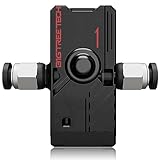The Best Filament Sensor of 2023 – Reviewed and Top Rated
After hours researching and comparing all models on the market, we find out the Best Filament Sensor of 2023. Check our ranking below.
2,919 Reviews Scanned
- 【Smart Filament Sensor】BIGTREETECH SFS V2.0 can not only detect filament runout, but also filament breakage, filament clogging, filament tying and even extruder malfunction. Detecting above abnormal extrusion cases, BTT SFS V2.0 will send error alerts to screen and automatically stop printing to keep you away from filament and electricity waste.
- 【Sensitive Photoelectric Filament Detector】BTT filament detection module adopts photoelectric sensor whose theoretical detection length can reach up to 2.88mm, much shorter than 7mm of SFS V1.0. Such improvement enables SFS V2.0 longer service life and higher precision in filament abnormality detection. Note: 2.88 mm is the minimum detection length for the sensor to function properly. If ‘false triggers’ error occurs, try to increase the detection length by 1mm until the problem is resolved.
- 【Bilateral Feeding】BIGTREETECH smart filament sensor V2.0 allows bi-directional feeding, which removes you from hard discrimination of filament inlet and outlet. Such upgrading enables more flexible installation and can maximize space utilization of your 3d printer! SFS V2.0 weighs only 36g, greatly reducing inertia added to the direct-drive extruder for higher printing speed and accuracy.
- 【Easy to Install】Our filament run out sensor is designed with 3 mounting holes on the back for easy installation onto your 3d printer with only a bracket. The bracket stl file can be downloaded in BTT github web: bigtreetech/smart-filament-detection-module/tree/master. The filament feeding lever serves for easy flexible filament loading. Please feel free to contact us if you have any doubts.
- 【Wide Compatibility】BIGTREETECH filament jam sensor can be mounted both on bowden extruder and direct drive extruders. It supports any motherboard with available I/O ports(Endstop, filament detection, BL touch, induction sensor, etc), like SKR MINI E3 V3.0 / SKR3 / SKR 3 EZ / SKrat / Manta E3EZ / Octopus Pro. And SFS V2.0 is compatible with Klipper, Marlin and RepRap firmwares.
- ★【3D Printer Accessories】Very practical filament detection sensor module, ideal accessories for 3D printer, making your printing work smooth and relieved.
- ★【Main Function】For checking the filament is whether run out or not, it automatically stops the 3D Printer when the filament runs out.
- ★【Filament Detection Module】Newly designed smart module, The main board executes the pause command operation when the filament is run out.
- ★【Extended Product Life】A wear-resistant copper sleeve is added to the feed port and the discharge port at the same time can effectively prolong the service life of the product.
- ★【After-sales Guarantee 】Each defective item can be replacement for free or refund. If any question, please feel free to contact or QA us, we will try our best to service you.
- This sensor detector is compatible with Anycubic Kobra 2 Neo/Kobra 2 Pro/Kobra 2 Plus/Kobra 2 Max/Kobra 2 3D Printer with 1.75mm Filament.
- Package includes: 2 X Filament Detection Module for Kobra 2 Series.
- Smart Filament Detector: It stops automatically when the filament runs out, very convenient for monitoring the consumables.
- Filament detection module: The motherboard executes a pause command operation when the filament is run out.
- Adding wear-resistant copper sleeves to both the inlet and outlet can effectively extend the service life of the product.
- 【High Compatible】 Suitable for Ender 3/ Ender 3 V2/ Ender 3 pro /Ender 3 MAX/Ender 5 Plus/ CR-10S PRO/ CR-10 V2 V3 with 32 bit V4.2.2/V4.4.7. Only Ender 3 Series need to replace extruder bracket.
- 【Smooth filament travelling】 The filament sensor has a built-in filament guider, which is made of metal material with smooth surface, reducing friction resistance and ensuring smooth filament feed-in.
- 【Precise Detection】 Blue LED indicates normal filament feed-in, when the Blue LED turns off, it means filament runs out.
- 【Upgraded Design】It is redesigned with new inner structure. The outer cover is frosted, making it stylish and unique.
- 【After Sales Service】Creality pays great attention to the buyer’s user experience. If you have unsolvable problems during installation and use, please feel free to contact us, our after-sales technical team will provide you with detailed solutions within 24 hours.
- Brand /Manufacturer:Flashforge
- Original Adventurer 5M and 5M Pro 3D printer filament sensor
- Smart Filament Detector stops automatically when the filament runs out, very convenient for monitoring the filaments
Last update on 2025-07-04 / Affiliate links / Product Titles, Images, Descriptions from Amazon Product Advertising API
How Do You Buy The Best Filament Sensor?
Do you get stressed out thinking about shopping for a great Filament Sensor? Do doubts keep creeping into your mind? We understand, because we’ve already gone through the whole process of researching Filament Sensor, which is why we have assembled a comprehensive list of the greatest Filament Sensor available in the current market. We’ve also come up with a list of questions that you probably have yourself.
We’ve done the best we can with our thoughts and recommendations, but it’s still crucial that you do thorough research on your own for Filament Sensor that you consider buying. Your questions might include the following:
- Is it worth buying an Filament Sensor?
- What benefits are there with buying an Filament Sensor?
- What factors deserve consideration when shopping for an effective Filament Sensor?
- Why is it crucial to invest in any Filament Sensor, much less the best one?
- Which Filament Sensor are good in the current market?
- Where can you find information like this about Filament Sensor?
We’re convinced that you likely have far more questions than just these regarding Filament Sensor, and the only real way to satisfy your need for knowledge is to get information from as many reputable online sources as you possibly can.
Potential sources can include buying guides for Filament Sensor, rating websites, word-of-mouth testimonials, online forums, and product reviews. Thorough and mindful research is crucial to making sure you get your hands on the best-possible Filament Sensor. Make sure that you are only using trustworthy and credible websites and sources.
We provide an Filament Sensor buying guide, and the information is totally objective and authentic. We employ both AI and big data in proofreading the collected information. How did we create this buying guide? We did it using a custom-created selection of algorithms that lets us manifest a top-10 list of the best available Filament Sensor currently available on the market.
This technology we use to assemble our list depends on a variety of factors, including but not limited to the following:
- Brand Value: Every brand of Filament Sensor has a value all its own. Most brands offer some sort of unique selling proposition that’s supposed to bring something different to the table than their competitors.
- Features: What bells and whistles matter for an Filament Sensor?
- Specifications: How powerful they are can be measured.
- Product Value: This simply is how much bang for the buck you get from your Filament Sensor.
- Customer Ratings: Number ratings grade Filament Sensor objectively.
- Customer Reviews: Closely related to ratings, these paragraphs give you first-hand and detailed information from real-world users about their Filament Sensor.
- Product Quality: You don’t always get what you pay for with an Filament Sensor, sometimes less, and sometimes more.
- Product Reliability: How sturdy and durable an Filament Sensor is should be an indication of how long it will work out for you.
We always remember that maintaining Filament Sensor information to stay current is a top priority, which is why we are constantly updating our websites. Learn more about us using online sources.
If you think that anything we present here regarding Filament Sensor is irrelevant, incorrect, misleading, or erroneous, then please let us know promptly! We’re here for you all the time. Contact us here. Or You can read more about us to see our vision.
FAQ:
Q: How does the optical filament sensor detect movement?
A: The optical filament sensor detects the presence of a filament and also its movement. Make sure you are running the latest firmware since new versions offer a higher-frequency sensing algorithm and improved reliability. If you want to test your filament sensor, visit MK3 safety features – how to test them.
Q: How does a filament runout sensor work on a printer?
A: This filament runout sensor is designed for detect whether your filament is run out during the printing process. The sensor will send the signal to the printer when the filament is run out and printer will pause the print job until the new filament is loaded when the printer w/ correct firmware and setting.
Q: Why do you need a filament sensor in a 3D printer?
A: A filament sensor may sound like something very unimportant but on the contrary, you need it for your 3D printer. The idea behind it is very simple but it can save you a lot of headaches down the road.
Q: What to do if your filament sensor is not loaded?
A: If you think that the filament was not loaded properly, press [Filament not loaded], which will push through the same amount of filament as before. If the color is not clear, then press [Color not clear], this way it will push through only a bit of filament.





